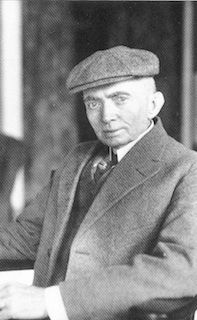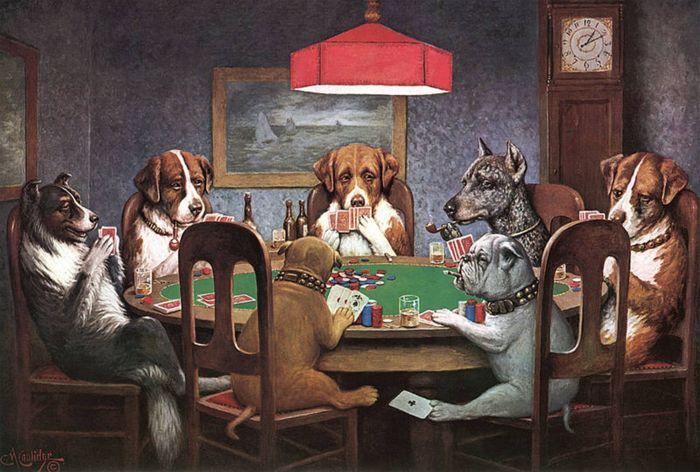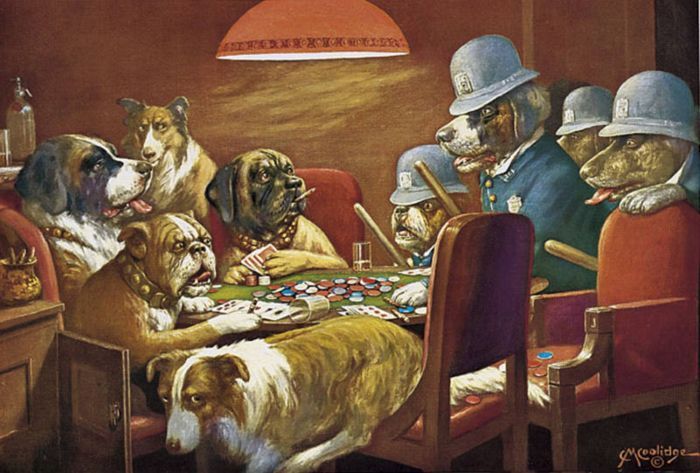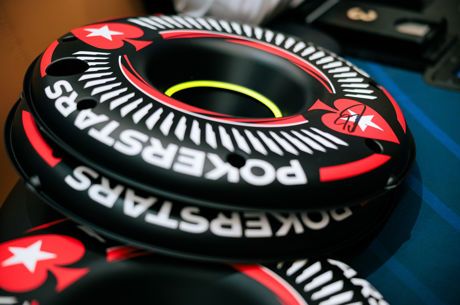Dogs Playing Poker: A Timeless Piece of Pop Culture Art

Table Of Contents
When asked to name examples of poker turning up in popular culture, a famous painting of a group of dogs playing poker likely springs to mind as a first choice for many — even before W.C. Fields peering out from under the brim of his stovepipe hat over a poker hand or the chorus of "The Gambler" by Kenny Rogers.
Everyone knows it, that absurd gathering of different breeds smoking cigars, drinking whiskey and beer, and playing cards as though they were human. You don't even have to play poker to be familiar with the poker-playing dogs, regarded by some as the epitome of kitsch or lowbrow culture, by others as an effective, insightful commentary on the middle and upper classes.
Even so, many don't know about the origins of "Dogs Playing Poker" — nor that there wasn't just a single painting, but several of them. Let's delve a bit into these images of poker that may well rank among the most familiar depictions of the game ever produced by mainstream popular culture.
Who Painted Dogs Playing Poker?
The man behind the poker-playing canines is Cassius Marcellus Coolidge. Born in upstate New York in 1844, Coolidge lived a colorful life. Known to friends as “Cash,” he worked as a banker, sign painter, and even comic opera writer.
Coolidge’s entrepreneurial flair extended to creating “comic foregrounds”—those carnival cut-outs where you stick your head through a hole. He additionally worked as a journalist, writing a column for which he drew his own illustrations.
Coolidge always painted and drew, successfully selling a number of his illustrations to various outlets. As early as the 1870s he had begun painting dogs, with a cigar company purchasing some to include on their boxes. A few of these early depictions of dogs featured them adopting human poses, including one in particular from 1894 showing four St. Bernards playing poker. That one — simply titled "Poker Game" — would prove a precursor of more such paintings to come.
But it wasn’t until 1903 that he created his most famous work: a series of oil paintings for the Brown & Bigelow advertising firm.

By that time, Coolidge was nearly 60, but produced 16 different paintings for Brown & Bigelow, all of which featured dogs engaged in various human activities.
How Many Paintings Are in the Dogs Playing Poker Series?
Of the 16 paintings for the calendars, seven of them featured the dogs doing other non-poker things such as attending a baseball game, conducting a trial, playing pool, struggling over a broken down Model T, and celebrating New Year's Eve. The other nine all show them playing poker, and when considered as a sequence convey many different scenarios and settings commonly associated with our favorite card game.
Perhaps the most famous of the series, "A Friend in Need" shows a group of dogs around a poker table. Look closely, and you’ll see a cigar-chomping bulldog sneaking an Ace to his ally. This humorous detail is one of the reasons this painting became a pop culture icon.

Two of the paintings, "A Bold Bluff" and "Waterloo," tell a sequential story in a manner that recalls the works of the great 18th-century artist William Hogarth.
In the first, a confident St. Bernard pushes in a large stack of chips, while in the second the same dog's hand is revealed to be just a pair of deuces. However, he still wins the pot much to the dismay of his opponents
For some of the paintings, Coolidge moves the dogs' games to other locations. "His Station and Four Aces" shows them playing on a train, with the dogs wearing an assortment of hats and coats suitable for travel. Another painting, "Stranger in Camp," finds the dogs at a campsite, apparently in conflict as the chips and cards are all scattered about with two of the players locked in what looks to be a pre-fight staredown.
"Poker Sympathy" shows a poor boxer falling back in his chair, his beer spilled and his four aces sliding off the table in response to seeing his opponent's straight flush. "Post Mortem" shows the cards stacked on table with just three dogs seated around it, still drinking, smoking cigars, and ostensibly discussing the night's activities. "Pinched with Four Aces" takes us back to the home game, this time being broken up by four dogs in police uniforms.

"Sitting Up with a Sick Friend" is the only one of the nine Brown & Bigelow paintings to feature female dogs, so designated by their fashionable hats. Given the scene, the title appears to describe the lie told by the men to the women regarding the true nature of their gathering — a situation prefiguring the one in the 1912 film A Cure for Pokeritis. One of the female dogs has an umbrella raised as if to strike one of the players, as a guilt-confirming playing card falls from the table in the foreground.
Finally in 1910 came one last painting featuring yet another suspenseful scene from a private game where a big bet has been made and a table full of dogs (including one more female spectator) eye the bettor warily. The title of that one could refer both to the hand the bettor holds and his four similarly suspicious opponents — "Looks Like Four of a Kind."
How Dogs Playing Poker Influenced Pop Culture
All of these paintings — either collectively or singly — get commonly referred to by the generic title "Dogs Playing Poker." Among the various ideas they convey, they certainly help document how by the turn of the 20th century poker had found its way from gaming dens, saloons, and steamboats into private homes.
In a 2002 New York Times article, Coolidge's daughter, Gertrude Marcella Coolidge, then 92, tells how she and her mother preferred cats to dogs, and wonders what the paintings would have been like had her father gone in a different direction.
"You can't imagine a cat playing poker," she ultimately decides. "It doesn't seem to do."
Over the years the popular paintings have been widely reproduced in a variety of media, including as posters, figurines, needlepoint kits, clocks, coasters, and, most suitably, on the backs of playing cards, not to mention being frequently alluded to in countless other works of popular culture, including television shows, music, plays, films, and even video games.
At least a few among the upper class continue to like them as well. At an auction in 2005, a private collector from New York City purchased the originals of "A Bold Bluff" and "Waterloo" for a cool $590,400. Then last year the initial painting "Poker Game" sold in another auction for $658,000.
Dogs Playing Poker FAQs
Who painted Dogs Playing Poker?
Cassius Marcellus Coolidge, an American artist, created the iconic Dogs Playing Poker series in the early 1900s.
How many paintings are in the Dogs Playing Poker series?
The series includes 16 paintings, nine of which feature dogs playing poker. The others show dogs engaging in various human activities.
What is the most famous Dogs Playing Poker painting?
The most well-known painting is A Friend in Need, which depicts a bulldog sneaking an ace to his ally during a game.
Why were the Dogs Playing Poker paintings created?
Coolidge painted them as part of a marketing campaign for Brown & Bigelow, an advertising firm, to promote cigars through their calendars.
How much are Dogs Playing Poker paintings worth?
Original paintings from the series have fetched high auction prices, with Poker Game selling for $658,000 in 2015.
Adapted from "Poker & Pop Culture: Telling the Story of America’s Favorite Card Game" by Martin Harris.









